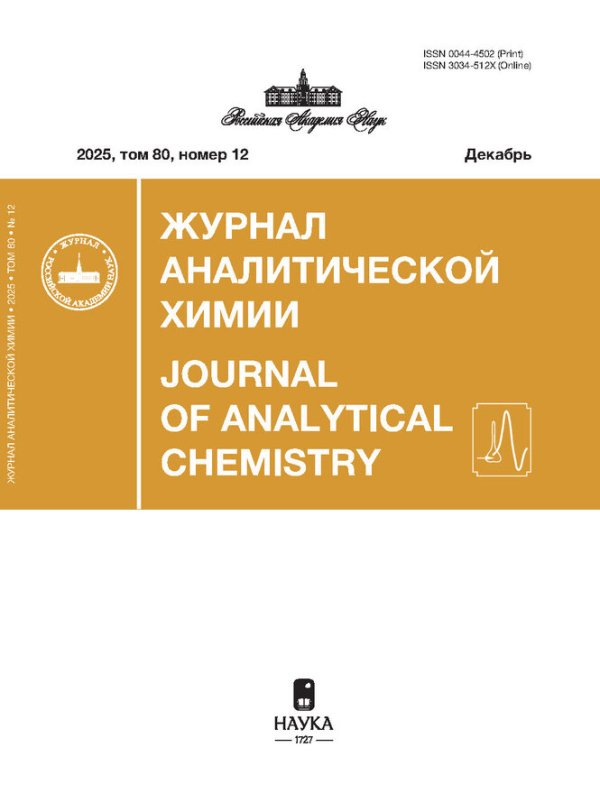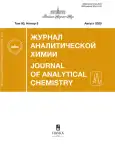Determination of oxidative damage markers of nucleic acids 8-hydroxyguanosine and 8-hydroxy-2’-deoxyguanosine in urine by high performance liquid chromatography with tandem mass spectrometric detection
- Authors: Savelieva E.I.1, Karakashev G.V.1, Belyakov M.V.1, Venediktov A.S.1, Bikbulatov A.N.1
-
Affiliations:
- Research Institute of Hygiene, Occupational Pathology and Human Ecology of the Federal Medical and Biological Agency of Russia
- Issue: Vol 80, No 8 (2025)
- Pages: 865-876
- Section: ORIGINAL ARTICLES
- Submitted: 18.08.2025
- URL: https://journals.rcsi.science/0044-4502/article/view/304927
- DOI: https://doi.org/10.31857/S0044450225080091
- EDN: https://elibrary.ru/bmxlkl
- ID: 304927
Cite item
Abstract
About the authors
E. I. Savelieva
Research Institute of Hygiene, Occupational Pathology and Human Ecology of the Federal Medical and Biological Agency of Russia
Email: saveleva@rihophe.site
st. Kapitolovo, g.p. Kuzmolovsky, Vsevolozhsk district, Leningrad region, Russia
G. V. Karakashev
Research Institute of Hygiene, Occupational Pathology and Human Ecology of the Federal Medical and Biological Agency of Russiast. Kapitolovo, g.p. Kuzmolovsky, Vsevolozhsk district, Leningrad region, Russia
M. V. Belyakov
Research Institute of Hygiene, Occupational Pathology and Human Ecology of the Federal Medical and Biological Agency of Russiast. Kapitolovo, g.p. Kuzmolovsky, Vsevolozhsk district, Leningrad region, Russia
A. S. Venediktov
Research Institute of Hygiene, Occupational Pathology and Human Ecology of the Federal Medical and Biological Agency of Russiast. Kapitolovo, g.p. Kuzmolovsky, Vsevolozhsk district, Leningrad region, Russia
A. N. Bikbulatov
Research Institute of Hygiene, Occupational Pathology and Human Ecology of the Federal Medical and Biological Agency of Russiast. Kapitolovo, g.p. Kuzmolovsky, Vsevolozhsk district, Leningrad region, Russia
References
- Syslová K., Böhmová A., Mikoška M., Kuzma M., Pelclová D., Kačer P. Multimarker screening of oxidative stress in aging // Oxid. Med. Cell Longev. 2014. Article 562860.
- Giustarini D., Dalle-Donne I., Tsikas D., Rossi R. Oxidative stress and human diseases: Origin, link, measurement, mechanisms, and biomarkers // Crit. Rev. Clin. Lab. Sci. 2009. V. 46. P. 241.
- Reverri E.J., Morrissey B.M., Cross C.E., Steinberg F.M. Inflammation, oxidative stress, and cardiovascular disease risk factors in adults with cystic fibrosis // Free Radic. Biol. Med. 2014. V. 76. P. 261.
- Andrisic L., Dudzik D., Barbas C., Milkovic L., Grune T., Zarkovic N. Short overview on metabolomics approach to study pathophysiology of oxidative stress in cancer // Redox Biol. 2018. V. 14. P. 47.
- Ho E., Galougahi K.K., Liu C.-C., Bhindi R., Figtree G.A. Biological makers of oxidative stress: Applications to cardiovascular research and practice // Redox Biol. 2013. V. 1. P. 483.
- Rodrigo R., Libuy M., Feliú F., Hasson D. Oxidative stress-related biomarkers in essential hypertension and ischemia-reperfusion myocardial damage // Dis. Markers. 2013. V. 35. P. 773.
- Zinellu E., Zinellu A., Fois A. G., Carru C., Pirina P. Circulating biomarkers of oxidative stress in chronic obstructive pulmonary disease: A systematic review // Respir. Res. 2016. V. 17. P. 150.
- Shroff A., Mamalis A., Jagdeo J. Oxidative stress and skin fibrosis // Curr. Pathobiol. Rep. 2014. V. 2. P. 257.
- Araki E., Nishikawa T. Oxidative stress: A cause and therapeutic target of diabetic complications // J. Diabetes Investig. 2010. V. 1. P. 90.
- Niedzielska E., Smaga I., Gawlik M., Monieczewski A., Stankowiez P., Pera J., Filip M. Oxidative stress in neurodegenerative diseases // Mol. Neurobiol. 2016. V. 53. P. 4094.
- Padurariu M., Ciobica A., Lefter R., Serban I.L., Stefanescu C., Chirita R. The oxidative stress hypothesis in Alzheimer’s disease // Psychiatr. Danub. 2013. V. 25. P. 401.
- Kino K., Hirao-Suzuki M., Morikawa M., Sakaga A., Miyazawa, H. Generation, repair and replication of guanine oxidation products// Genes Environ. 2017. V. 39. P. 21.
- Schaich M.A., Weaver T.M., Roginskaya V., Freudenthal B.D., Van Houten B. Single-molecule analysis of purified proteins and nuclear extracts: Insights from 8-oxoguanine glycosylase 1 // DNA Repair. 2024. V. 134. Article 103625.
- Nie J.J., Pian Y.Y., Hu J.H., Fan G.Q., Zeng L.T., Ouyang Q.G. Increased systemic RNA oxidative damage and diagnostic value of RNA oxidative metabolites during Shigella flexneri-induced intestinal infection // World J. Gastroenterol. 2021. V. 27. № 37. P. 6248.
- Guo C., Chen Q., Chen J., Yu J., Hu Y., Zhang S., Zheng S. 8-Hydroxyguanosine as a possible RNA oxidative modification marker in urine from colorectal cancer patients: Evaluation by ultra performance liquid chromatography-tandem mass spectrometry // J. Chromatogr. B: Anal. Technol. Biomed. Life Sci. 2020. V. 1136. Article 121931.
- Broedbaek K., Ribel-Madsen R., Henriksen T., Weimann A., Petersen M., Andersen J.T. Genetic and environmental influences on oxidative damage assessed in elderly Danish twins // Free Radic. Biol. Med. 2011. V. 50. № 11. P.1488.
- Hofer T., Seo A.Y., Prudencio M., Leeuwenburgh C. A method to determine RNA and DNA oxidation simultaneously by HPLC-ECD: Greater RNA than DNA oxidation in rat liver after doxorubicin administration // Biol. Chem. 2006. V. 387. № 1. P. 103.
- Liu Q., Liu Z., Wang C.C., Gao X., Li C.B., Wang M., Wang Q., Cai J.P. Increased production of 8-oxo-7,8-dihydroguanine in human urine, a novel biomarker of osteoporosis // Free Radic. Res. // 2022. V. 56. № 5–6. P. 358.
- Liu Z., Wang J.J., Liu Q., Li J., Jiang S., Ma Y.Q., Dang Y.M., Cai J.P. Urinary 8-oxoGuo as a potential novel evaluation index for patients with nephrotic syndrome // Free Radic. Res. 2022. V. 56. № 11–12. P. 691.
- Shimoi K., Kasai H., Yokota N., Toyokuni S., Kinae N. Comparison between high-performance liquid chromatography and enzyme-linked immunosorbent assay for the determination of 8-hydroxy-2′-deoxyguanosine in human urine // Cancer Epidemiol. Biomark. Prev. 2002. V. 11. P. 767.
- Ravanat J., Guicherd P., Tuce Z., Cadet J. Simultaneous determination of five oxidative DNA lesions in human urine // Chem. Res. Toxicol. 1999. V. 12. P. 802.
- Chiorcea-Paquim, A.-M. 8-oxoguanine and 8-oxodeoxyguanosine biomarkers of oxidative DNA damage: A review on HPLC–ECD determination // Molecules. V. 27. № 5. P. 1620.
- Pilger A., Ivancsits S., Germadnik D., Rüdiger H.W. Urinary excretion of 8-hydroxy-2′-deoxyguanosine measured by high performance liquid chromatography with electrochemical detection // J. Chromatogr. B. 2002. V. 778. P. 393.
- Zhao G., Fu Y., Yu J., Wang S., Duan K., Xie F., Liu H. A Simple method for the determination of 8-oxoguanosine, 8-oxo-2′-deoxyguanosine and 8-iso-prostaglandin F2α in human urine by UHPLC–MS/MS // Chromatographia. 2017. V. 80. № 3. P. 401.
- Каюков И.Г., Галкина О.В., Тимшина Е.И., Зубина И.М., Михеева А.Ю., Бердичевский Г.М. Креатинин в современной оценке функционального состояния почек (Обзор литературы и собственные данные) // Нефрология 2020. T. 24. № 4. C. 21.
- Wu L.L., Chiou C.C., Chang P.Y., Wu J.T. Urinary 8-OHdG: A marker of oxidative stress to DNA and a risk factor for cancer, atherosclerosis and diabetics // Clin. Chim. Acta. 2004. V. 339. № 1-2. P. 1.
- Martinez-Moral, M.-P., Kannan, K. Analysis of 19 urinary biomarkers of oxidative stress, nitrative stress, metabolic disorders, and inflammation using liquid chromatography–tandem mass spectrometry // Anal. Bioanal. Chem. 2022. V. 414. № 6. P. 2103.
- Lu Z., Li Q., Dai Y., Pan X., Luo X., Peng R., Guo C., Tan L. Association of co-exposure to polycyclic aromatic hydrocarbons and phthalates with oxidative stress and inflammation // Sci. Total Environ. 2024. V. 912. Article 169513.
- Lin X.Y., Liu Y.X., Zhang, Y.J., Shen, H.M., Guo, Y. Polycyclic aromatic hydrocarbon exposure and DNA oxidative damage of workers in workshops of a petrochemical group // Chemosphere. 2022. V. 303. Article 135076.
- Shih Y.M., Cooke M.S., Pan C.H., Chao M.R., Hu C.W. Clinical relevance of guanine-derived urinary biomarkers of oxidative stress, determined by LC-MS/MS // Redox Biol. 2019. V. 20. P. 556. doi: 10.1016/j.redox.2018.11.016
- Malayappan B., Garrett T.J., Segal M., Leeuwenburgh C. Urinary analysis of 8-oxoguanine, 8-oxoguanosine, fapy-guanine and 8-oxo-2’-deoxyguanosine by high-performance liquid chromatography-electrospray tandem mass spectrometry as a measure of oxidative stress // J. Chromatogr. A. 2007. V. 1167. № 1. P. 54.
- Li Y.S., Fujisawa K., Kawai K. Diurnal and daily fluctuations in levels of the urinary oxidative stress marker 8-hydroxyguanosine in spot urine samples // Genes Environ. 2025. V. 47. № 1.
- Cordes J., Zhao S., Engel C. M., Stingele J. Cellular responses to RNA damage // Cell. 2025. V. 188. № 4. P. 885.
Supplementary files











